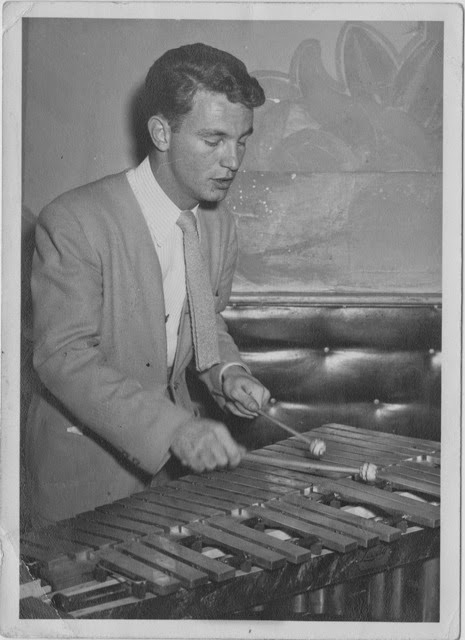Sunday, February 8, 2015
A Cal Tjader Favorite: Paul Horn
Paul Horn died on June 29, 2014 at the age of 84, but I didn't become aware of the sad news until Australian didgeridoo player Stephen Kent––identifying a track by his former colleague–– mentioned it on the radio in January of 2015. Horn is well known as a pioneer of spiritual or "New Age" music, beginning with recordings made during his first trip to India in 1967 and especially Inside the Taj Mahal––his beautiful flute sounds were taped on location on April 25, 1968. He went forward to have a highly successful career making albums of this nature, including Inside the Great Pyramid (1976), Inside Canyon de Chelly (1997), Inside Monument Valley (1999)––the latter two with American Indian (Navajo & Ute) flutist R. Carlos Nakai––and many others.
Lesser known, especially to the ears of Horn's younger listeners, was his superlative career as an innovative jazz musician, both as a sought after sideman and leader. Something Blue and Profile of a Jazz Musician are among his acclaimed LPs. I first came into contact with Paul while researching my Cal Tjader biography. I interviewed him by phone––he spent winter/spring in Tuscon, Arizona and summer/fall on Cortes Island, off the coast of British Columbia––on January 27, 2005. He was irritable during the start of our late conversation––possibly the result of a rough day––but then relaxed and spoke about his early years in jazz and more than six-year (Summer of 1958-1964) association with Tjader. Although memories of specific events were few, Horn offered some keen insights about the jazz scene, as highlighted in this passage:
"In general, [Tjader} was just really a likable guy. I never saw him get upset or loose his temper. He was even keeled. Everything just went smooth, man. The way it should be. The way it was basically with my bands too. If you are going to have a small group, four or five pieces, Dave Brubeck is a perfect example of this, it’s a family. It’s built on mutual respect, a love for the music and just having a good time when you are together. Otherwise, you can’t play the music. The music evolves out of the relationship of the guys in the band. It’s not just that they’re all good musicians and they are all playing their instruments great. ...It’s that feeling of camaraderie, if you will, and playing together a lot and hanging out. When you are on the road, after the gig, usually everyone doesn’t just go their own way. You might get something to eat. ...Then he magic starts happening in the band. It’s like the extra sensory things when you’re improvising or just have no idea of what you are going to do next. You’re just there in the moment. You can get five great musicians individually and put them together for the first time and that “X” factor is not going to be there. That only comes from working together and hanging out, a family type of arrangement."
In October of 2005, Horn performed in concert with Stephen Kent at San Francisco's Grace Cathedral. The concert exposed attendees to exotic sounds––a variety of flutes, some from other parts of the world, and several didgeridoos–– that were right in tune with this majestic venue. Afterwards, Horn and I had a friendly conversation concerning his music. He mentioned that he had continued to play (and occasionally record) jazz over the years. In fact, he had recently played in southern California with vibist Emil Richards and other former musical associates. He smiled when he recounted how fun it was to bring back the old charts. Although we spoke of getting together again, the distance between us and his schedule were obstacles. However, we did stay in touch by phone, both for follow-up interviews and discussions about what was going on in our lives, such as his marriage to Canadian vocalist/songwriter Ann Mortifee, their musical collaborations, the wedding of one of his children, the tranquility of life at a cabin he shared with Mortifee on Cortes Island and the warm winters of Tucson, among other things. He had a healthy ego, but not of the negative kind; the feeling was pride in what he had accomplished. Moreover, he displayed a genuine interest not only in the progress I was making with the Tjader project but my personal life as well. His warmth and encouragement were positive influences for me. Two weeks or so after receiving the Tjader biography, he called both to say how impressed he was with the work that I had put into the book and that he thought it was well done. Lastly, he reiterated what he had been telling me for close to a decade: "I'm so happy you are doing this for Cal. He's smiling down on you and thanking you."
Paul Horn performed as a featured guest, mainly on flute but occasionally on alto sax, with Cal Tjader's groups in concert, including several landmark West Coast jazz festivals detailed further in my book, and in the studio. He can be heard on––CD title is listed second if different than LP title––Latin for Lovers (Sentimental Moods), Concert by the Sea, Vols. 1 & 2 (Monterey Concerts), Cal Tjader Goes Latin (Black Orchid), West Side Story (Cal Tjader Plays Harold Arlen & West Side Story), Cal Tjader Plays/Mary Stallings Sings, In a Latin Bag and Cal Tjader Plays the Contemporary Music of Mexico and Brazil.
Subscribe to:
Posts (Atom)

